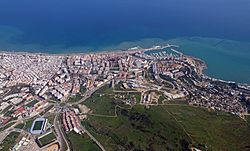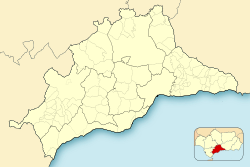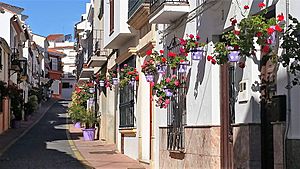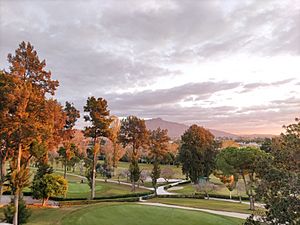Estepona facts for kids
Quick facts for kids
Estepona
|
|||
|---|---|---|---|
 |
|||
|
|||
| Sovereign state | |||
| Autonomous community | |||
| Province | |||
| Comarca | Costa del Sol Occidental | ||
| Area | |||
| • Total | 137 km2 (53 sq mi) | ||
| • Land | 137 km2 (53 sq mi) | ||
| • Water | 0.00 km2 (0 sq mi) | ||
| Population
(2018)
|
|||
| • Total | 67,012 | ||
| • Density | 489.1/km2 (1,267/sq mi) | ||
| Time zone | UTC+1 (CET) | ||
| • Summer (DST) | UTC+2 (CEST) | ||
| Website | http://www.estepona.es/ | ||
Estepona is a lively town and municipality located on the Costa del Sol in southern Spain. It's part of the province of Málaga in the region of Andalusia. The area covers about 137 square kilometers, with green valleys and mountains like the Sierra Bermeja, which reaches 1,449 meters high.
Estepona is famous for its beautiful beaches, which stretch for about 21 kilometers along the coast. It's a very popular place for holidays and vacations.
Thanks to its location between the sea and mountains, Estepona has a special climate. It enjoys more than 325 sunny days every year!
This makes Estepona a great place to visit all year round. It has two beaches that have received the EC Blue Flag beach award, which means they are very clean and safe. There's also a modern sports marina with many places to eat tapas and other delicious foods. The town center has charming white-walled buildings, lots of shops, and pretty squares. Did you know that in the early 1990s, Walt Disney Company first thought about building Eurodisney here before choosing Paris?
Contents
History of Estepona
The area where Estepona is today has been lived in for a very long time. Scientists have found stone-age tools and ancient stone structures called dolmens.
Ancient Times
The Romans lived here too. But in the 4th century, a powerful earthquake in the sea destroyed their town. Archeologists have found some old building foundations and pottery. It's hard to find more because of the earthquake and new buildings put up in the 1960s. Some old writings mention a port called 'Salduba' or 'Silniana,' which might have been Estepona.
Moorish Rule and Christian Conquest
The name 'Estepona' likely comes from the Moorish words Astabbuna or Al-extebunna. In 1342, a big sea battle, called the Battle of Estepona, happened in the bay. It was between the fleet of the Crown of Aragon (from Spain) and the Marinid Dynasty (from North Africa). The Aragonese won that battle.
Later, in 1457, Henry IV of Castile captured the town from the Moors. A church was built where the town's mosque used to be. A town grew around it, but it was also destroyed later. All that remains from that time is the old clock tower. The San Luis castle was built to protect the coast from pirates.
Becoming a Town
In 1502, the town received its first official document, called a charter. This was for the 25 Christian families who had moved there from northern Spain. However, Estepona was managed by the nearby town of Marbella until 1729. That year, Philip V of Spain gave Estepona its own town charter, allowing it to govern itself. By the early 1900s, Estepona had about 9,000 people, mostly farmers and fishermen.
Getting Around Estepona
Estepona is easy to reach. The closest international airport is Gibraltar Airport, about 45 kilometers away. It has flights to cities in the UK. Another major airport is Málaga Airport, about 80 kilometers away.
Roads and Travel
Estepona is connected by the Autovía A-7, a main road that runs along the Costa del Sol. There's also a toll road, the Autopista AP-7. This road is faster because it bypasses many towns like Marbella, but you have to pay a fee to use it. The cost changes throughout the year, but it's usually less than 10 euros for a regular car from Málaga to Estepona.
There are also plans for a Costa del Sol railway to connect Málaga to Estepona, passing through Marbella.
Estepona Port and Marina
The Estepona Port and Marina is a busy place! It's a working fishing port where you can see boats bringing in their catch. There are also many restaurants and bars. Every day, there are auctions where fresh seafood is sold.
The port is also home to the Estepona street market. Here, you can find many stalls selling clothes, leather goods, and other items. The market is usually in Estepona on Sundays, but it travels to other towns in the Málaga province too.
Climate in Estepona
Estepona has a warm, sunny climate called a subtropical Mediterranean climate. This means it has very mild, slightly wet winters and hot, very dry summers.
In summer, it's hot and dry, with steady temperatures. It's not unusual for temperatures to go above 35 degrees Celsius (95 degrees Fahrenheit). Winter temperatures are very mild, with daytime highs around 18 degrees Celsius (64 degrees Fahrenheit) and lows around 11 degrees Celsius (52 degrees Fahrenheit). The average temperature for the whole year is over 19 degrees Celsius (66 degrees Fahrenheit). The city gets more than 300 sunny days each year, with about 2,800 to 3,000 hours of sunshine.
| Climate data for Estepona, Spain | |||||||||||||
|---|---|---|---|---|---|---|---|---|---|---|---|---|---|
| Month | Jan | Feb | Mar | Apr | May | Jun | Jul | Aug | Sep | Oct | Nov | Dec | Year |
| Mean daily maximum °C (°F) | 17.7 (63.9) |
18.4 (65.1) |
20.1 (68.2) |
21.3 (70.3) |
23.6 (74.5) |
27.2 (81.0) |
29.8 (85.6) |
30.0 (86.0) |
27.5 (81.5) |
23.9 (75.0) |
20.5 (68.9) |
18.3 (64.9) |
23.2 (73.7) |
| Daily mean °C (°F) | 14.3 (57.7) |
14.9 (58.8) |
16.4 (61.5) |
17.4 (63.3) |
19.5 (67.1) |
22.6 (72.7) |
24.9 (76.8) |
25.1 (77.2) |
23.1 (73.6) |
20.1 (68.2) |
17.0 (62.6) |
15.1 (59.2) |
19.2 (66.6) |
| Mean daily minimum °C (°F) | 10.9 (51.6) |
11.4 (52.5) |
12.6 (54.7) |
13.5 (56.3) |
15.3 (59.5) |
17.9 (64.2) |
19.9 (67.8) |
20.2 (68.4) |
18.7 (65.7) |
16.2 (61.2) |
13.5 (56.3) |
11.9 (53.4) |
15.2 (59.3) |
| Average precipitation mm (inches) | 108.1 (4.26) |
91.3 (3.59) |
67.4 (2.65) |
57.3 (2.26) |
27.6 (1.09) |
7.6 (0.30) |
0.3 (0.01) |
2.1 (0.08) |
26.7 (1.05) |
79.4 (3.13) |
124.2 (4.89) |
154.0 (6.06) |
746 (29.37) |
| Source: World Meteorological Organization (WMO) | |||||||||||||
Fun Places to Visit
Estepona and its surroundings offer many exciting places to explore.
Nearby Attractions
- Puerto Banús: This is a fancy area about 30 minutes drive from Estepona Port. It has many designer stores and luxury shops.
- Selwo Safari Park: This park is designed like an African safari. It's home to 2,000 animals living in conditions similar to the wild. It's about a 20-minute drive from Estepona Port.
- Palacio de Exposiciones y Congresos de Estepona: This is Estepona's main center for exhibitions and events. It hosts product shows, fairs, concerts, and more.
Art and Culture
- Ruta de Murales Artísticos: Take a fun walk around town to discover the Route of Artistic Murals. More than 40 large paintings decorate the sides of buildings, turning them into giant canvases!
Estepona's Beaches
Estepona has over 20 kilometers of coastline and 17 different beaches. Many are right next to hotels and homes outside the main town.
- Playa del Cristo: This beach is five minutes west of Estepona Marina. It's a small, calm cove, perfect for families with younger children because it's shallow and protected from the wind. It has lifeguards during the season, two beach restaurants, and a play area for kids.
- La Rada Beach: This is a much larger beach, over 2.5 kilometers long. It stretches from the marina past Estepona Old Town. It's the town's main beach and has a beautiful seafront promenade. You'll find everything you need here: bars, restaurants, play areas, showers, and lifeguards.
Estepona Old Town - Centro Historico
The San Luis castle (Castillo de San Luis) was built in the 15th century. Queen Isabella I ordered it to protect the town from invaders. Most of the narrow streets and small, one-story houses in the Old Town were built in the 18th and 19th centuries.
Today, the town council has improved over 100 streets and plazas. They've repaved streets, fixed sewers, and added colorful flowerpots. Each street even has its own color scheme! The people who live here are very proud of their beautiful streets, which are mostly free of cars now. Unlike some other old towns in Andalusia, these streets aren't just rows of shops and bars.
Food and Dining
Estepona isn't known for big nightclubs, but it has many different bars and restaurants. You can enjoy fresh, locally caught seafood. There are also many types of Mediterranean food, including Italian and French dishes. Many restaurants have outdoor seating, so you can eat al fresco (outside) in the evening.
Most restaurants are near the seafront, either along the main promenade or on Calle Real. There are also several small squares next to Calle Real with many restaurants.
Shopping in Estepona
Estepona has many small and medium-sized local shops, especially in the Old Town. You can find local products and handmade goods. The recently renovated indoor market in the town center has stalls selling fresh meat, fish, and vegetables. Boutiques in the main town center offer modern international clothing brands.
Like many Spanish towns, Estepona has a market in the main square on Wednesdays. It sells clothes, food, and vegetables. The Estepona port also has a Sunday market with items for tourists.
There are no huge shopping malls right in Estepona. The main food stores are a large supermarket complex on the edge of town and smaller stores in the center. The closest big department stores are in Puerto Banús and Marbella.
Sports and Golf
Cycling and tennis are very popular in Estepona. Many bike races happen in the area, and there are three major tennis clubs. Estepona is also a great place for golf, with many courses nearby:
- Estepona Golf
- Valle Romano Golf Club
- La Duquesa Golf & Country Club
- La Resina Golf & Country Club
- El Paraíso Golf Club
- Finca Cortesin - This course hosted the VOLVO World Match Play Championship several times.
- Doña Julia Resort
Important Landmarks
- The Town Clock Tower.
- The San Luis Castle.
- The Church of Los Remedios.
- The Original Bullring.
Local Celebrations
Estepona has many fun local festivals throughout the year:
- San Isidro Labrador: This is an agricultural religious celebration held on May 15th.
- Ferias y Fiestas mayores: The town's main annual festival takes place at the beginning of July.
- Quema de los bigotes de San Juan: A traditional celebration on June 23rd, the night of the summer solstice.
- Virgen del Carmen: Fishermen celebrate this religious festival on July 16th.
- Virgen de los Remedios: Another religious celebration held on August 15th.
Images for kids
See also
 In Spanish: Estepona para niños
In Spanish: Estepona para niños




























